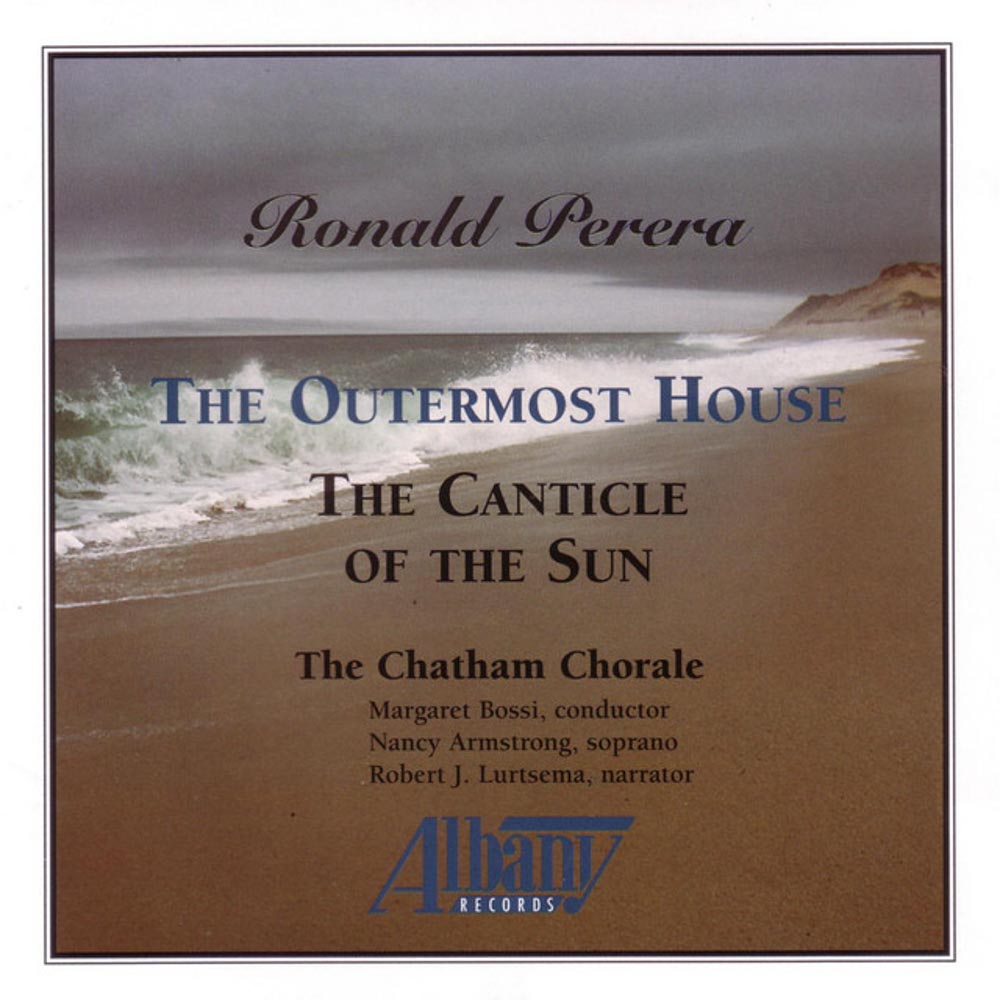Narrator, SATB chorus, Synthesized accompaniment (CD) or Keyboard
A dramatic cantata in which the narrator sets forth, in English, events from the life of St. Francis, and the chorus sings, in Italian, the sections of his famous poem. Commissioned for the 100th anniversary of Groton School. St. Francis of Assisi’s poetry praises the creation of the sun, moon, earth, wind, water, fire. Very appealing synthesized accompaniment, excellent historical/performance notes. (Italian text in Umbrian dialect.)

The Outermost House: The late Robert Lurtsema narrates these colorful, melodic works. Includes Robert Perera’s The Outermost House performed by Chatham Chorale, Margaret Bossi, conductor, Nancy Armstrong, soprano, Robert J. Lurtsema, narrator and The Canticle of the Sun performed by Chatham Chorale, Margaret Bossi, conductor, Robert J. Lurtsema, narratorand .Available on:
Albany Records
iTunes
Movements:
- Processional
- Reading No. 1
- Chorus, “Altissimu omnipotente bon signore”
- Reading No. 2
- Chorus, “Laudatu sie, mi signore”
- Reading No. 3
- Chorus, “Laudato si’, mi signore, per quelli che perdonano”
- Reading No. 4
- Chorus, “Laudato si’, mi signore, per sora nostra morte corporale”
- Reading No. 5
- Hymn, “Laudate et benedicite mi signore”
- Recessional
| Composed: | 1984 |
| Text by: | St. Francis of Assisi |
| Duration: | 21:00 |
| Publisher: | E. C. Schirmer Music Company |
| Catalog Number(s): | Complete Choral Score, 4280 Electronic Media, 4280A Mvt. 5 Laudato sie, mi signore available separately: Choral Score, 4084 Electronic Media, 4084A |
Reviews:
Perera’s ability to set text to memorable music is very much in evidence but, perhaps influenced by both his principal text being in Latin as well as his chosen accompaniment, there is a feeling of pastiche, albeit one of very high quality, that comes into play. There is, if you will, a Monteverdi-meets-Philip Glass sensibility about a lot of the music. Still, there are beautiful moments, such as the entire ninth movement, set for unaccompanied choir.
John Story, Fanfare Magazine, May/June 1999 (review of Albany Troy CD 314)
Composed in 1984, this “modern miracle play was not published until Canticle of the Sun was conceived as a liturgical drama in which Ronald Perera spins the story of the creation of a hymn of praise to God by the great St. Francis of Assisi, as seen in all things mortal and natural (“Brother Sun, Sister Moon,” for example). The forces include a mixed choir and a men’s choir who sing
in procession (accompanied by the handbell), a narrator, and a keyboard (perhaps more than one) or synthesized accompaniment
(available for purchase and well-cued in the score, but not provided for this review). An additional requirement, though not particularly noted, is an acoustically vibrant performing space; the choreography and interplay of instruments, voice, and narrator, need to blend and overlap in mystery.
The composer chose to set the saint’s words in their original Italian (and provides a much-appreciated recorded guide to pronunciation), with the narrator delivering the story of the origin of the work in English. For the piece to flourish, the drama involved should have equal importance with music, and one should take note that this is a lot of Italian to sing. Musically, the piece consists of Stravinskian might and angularity juxtaposed
with ravishing lyricism (“Laudato si,’ mi signore”) and a good dose of the mysterious (” … per sora nosrra morre corporale”). Though nor a derivative work in any sense, Carl Orff may be an influence in this macaronic mix of language,
style, and imagery. The work, though not major in length, is certainly major in heft and demands. It si divided into eleven sections, including opening and closing processions. Choruses and readings alternate throughout, with a concluding hymn, “Laudate et
benedicite mi signore.”
Those who admire the work of St. Francis and the work of modern Franciscans will be moved and inspired by this work. But who is to perform it? Perhaps a consortium of dedicated professional and volunteer singers willing to strive mightily in text, music, and movement to bring to the public a powerful, well-crafted mini-oratorio. This is not for
the faint of heart, although those who commit and engage in it will have their efforts blessed by the peacefulness of St. Francis.
The duration of the work is not indicated, but is estimated by this author to be approximately thirty minutes. The publisher also offers a version of only the choruses to permit a performance of those in concert format.
Richard Coffey, Choral Journal, February 2001
